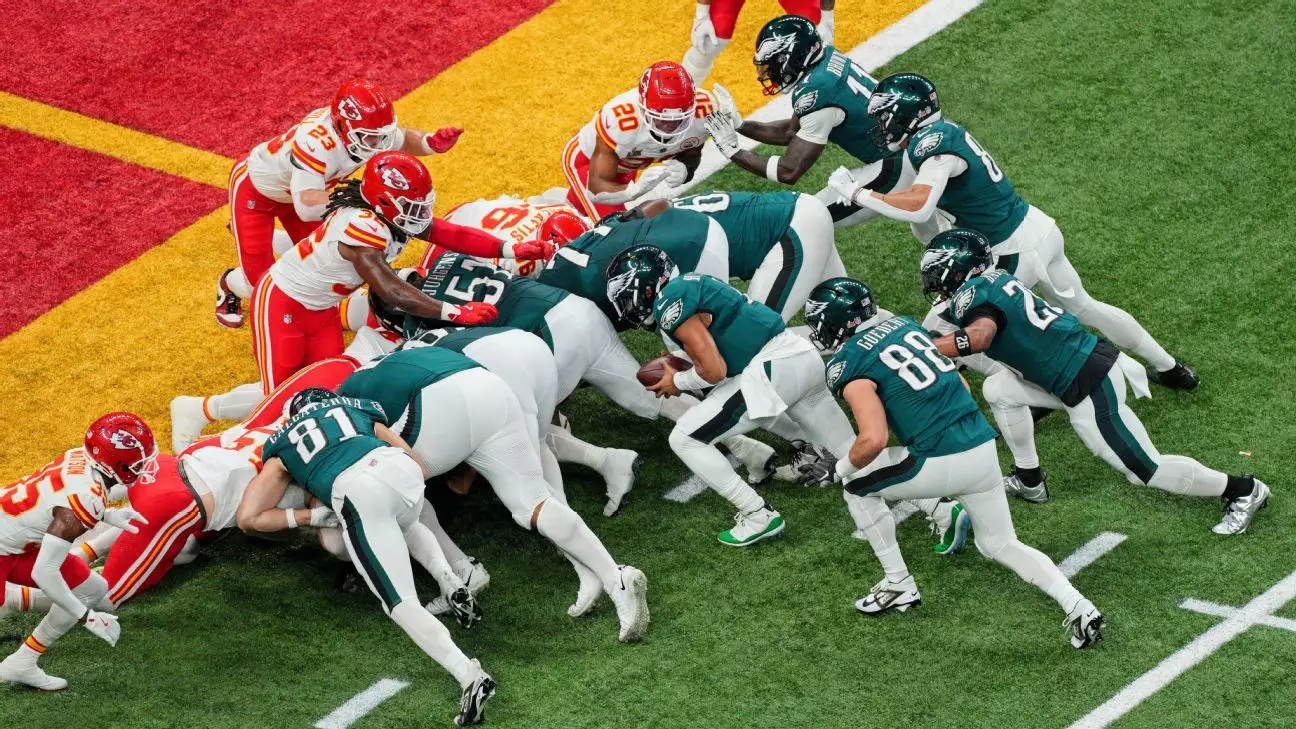The ongoing debates within the NFL about specific gameplay tactics continue to shape the league’s landscape significantly. Most recently, discussions have been ignited by a rule proposal aimed at banning the “tush push” quarterback sneak, a move that has polarized opinions in both media and fan circles. This examination seeks to explore the implications, origin, and broader context surrounding this proposal.
At its core, the “tush push”—often associated with teams like the Philadelphia Eagles—entails a quarterback sneak where players line up behind the quarterback to facilitate a forward shove. This strategy, though straightforward, has gained notoriety due to its exceptional effectiveness. Over the past three seasons, the Eagles and Buffalo Bills have executed 163 variations of this maneuver, achieving a success rate of 87% for touchdowns or first downs. In comparison, the rest of the league sits at a mere 71%. The high success rate has sparked conversations about fairness, strategy, and possible exploitation of the rule book.
The play’s evolution has been particularly fascinating. What began as a conventional QB sneak developed into a blend of brute force and tactical positioning, raising questions about player safety and competitive balance. While proponents argue that it showcases intelligent team dynamics and athletic prowess, detractors voice concerns regarding the risk of injury, particularly for defenders who face an uphill battle against a coordinated offensive surge.
The announcement of this rule proposal, although lacking identification of the submitting team, carries significant weight within the NFL. Troy Vincent, the league’s executive vice president of football operations, hinted at the collective sentiment among various franchises about the “tush push.” The league has seen mixed responses: some flaunt it as innovative, while others argue it sets a dangerous precedent that could disrupt standard forms of competition.
If the proposal proceeds to a vote—requiring a two-thirds majority—it may usher in a new chapter for NFL gameplay. Yet, it also raises important questions about the integrity of the sport. By potentially banning the “tush push,” the league would be attempting to suppress a tactic that has proven advantageous for certain teams, which could be construed as exerting a preferential treatment toward teams struggling to master or replicate its success.
Moreover, the league’s history of modifying rules to balance competition often leads to accusations of bias or favoritism. The Eagles’ coach, Nick Sirianni, notably criticized such movements by emphasizing that their team’s success stems from a deep understanding and execution of the play, not simply luck. His stance epitomizes a broader theme in sports: should individual skill and intelligence dictate the rules, or should uniform regulations govern all teams equally?
This particular proposal is not an isolated event. The NFL’s willingness to adapt its rule book in response to emerging strategies has characterized its evolution. The “hip drop” tackle, previously under scrutiny for safety concerns, marks a recent point of contention that demonstrates the league’s approach: addressing risks while attempting to maintain offensive and defensive parity.
Critics argue that the NFL’s rule adjustments often appear reactionary, responding to short-term trends rather than fundamental issues within game strategy. The league must carefully consider the impact of each rule change on gameplay dynamics and player safety. The implications stretch beyond just on-field performance; they resonate in team strategies, fan engagement, and even sponsorships tied to the game’s aesthetic value.
As the NFL deliberates the fate of the “tush push,” it reflects a larger narrative within sports culture: the balance between innovation and tradition. The efficacy of certain maneuvers will always challenge core regulations, providing a fertile ground for ongoing debate. It remains essential for the league to engage with all stakeholders, including players, coaches, and fans, to ensure that any changes foster both competitive integrity and the essence of the game.
In navigating these intricate waters, the NFL faces the precarious task of evolving without losing sight of what makes the sport compelling. The conversation surrounding the “tush push” embodies this struggle—highlighting both the challenges of modern football and the indelible spirit that keeps fans coming back for more.


Leave a Reply